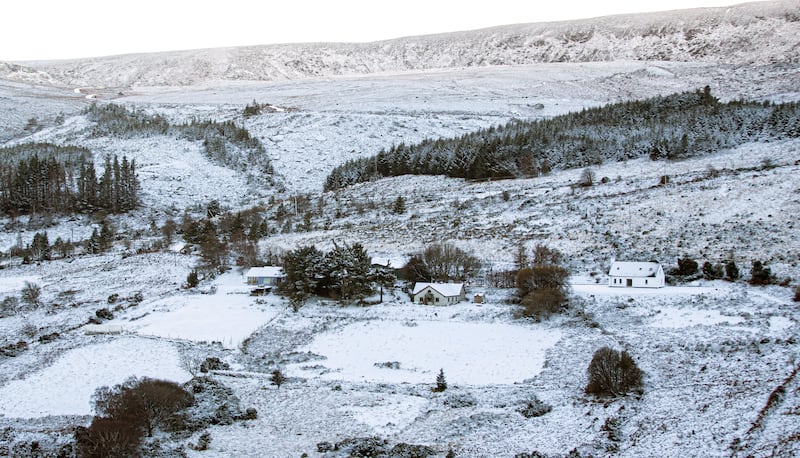As the country continues to cope with a prolonged freeze, Met Éireann has extended its orange weather warnings – the second most severe – into Friday, although the weekend should finally see some reprieve.
Yesterday forecsters warned Ireland was set to experience its lowest temperatures of the current cold snap on Wednesday night with parts of the midlands facing possible lows of -11 degrees.
On Tuesday night, temperatures dipped to a low of -7.9 degrees at the Mt Dillon weather station in Co Roscommon, but Wednesday and early Thursday morning threatened to go even lower.
“Quite widely we are expecting temperatures below -5 degrees and down to maybe -8, -9 degrees,” said Met Éireann meteorologist Andrew Doran-Sherlock.
READ MORE
“Very, very locally you could see temperatures drop a little bit lower than that but the vast majority wouldn’t experience a temperature like [-11]; it would generally be between the -8, -9 degrees.”
Should the numbers dip in minus double figures it will be somewhere in the midlands. The current weather extremities are all about temperatures and ice, as opposed to snow and sleet, and coastal counties will normally experience warmer conditions.
Still, most locations will not rise above zero degrees tomorrow morning because, explained Mr Doran-Sherlock, “the nights are so long and it takes a bit of time for daytime heating to have an effect”.
Temperature remained subdued through Wednesday, never rising above a high of six degrees, recorded in Co Wexford. The north and northwest of the country were due to experience some wintry showers on Wednesday night.
Met Éireann’s orange warning for Thursday was issued for low temperatures and ice in across the country, with the exception of Co Donegal, and more or less the same conditions flagged until midday Friday.
[ In Pictures: The 'Beast from the East' arrivesOpens in new window ]
[ A tale of woe during the 'Beast from the East'Opens in new window ]
Speaking on Raidió Teilifís Éireann (RTÉ) radio on Wednesday morning, Met Éireann’s Joanna Donnelly said the lowest temperature ever recorded in Ireland, at -19.1 degrees, dated back to January, 1881.
She said the lowest recent temperatures date back to 2010 when we had a “really cold Christmas day of minus 17.5 in Mayo”.
“But the ‘Beast from the East’ is probably the more familiar one that we can remember, which was minus 9.7 on March 1st in 2018.”
Ms Donnelly also said the possibility of snow on Christmas day should not be ruled out, but the Irish climate in general is not set up for white Christmases due to the predominantly warmer westerly airflow.
Whatever expectations the recent cold snap has set, temperatures are due to rise this weekend, possibly into double digits by Sunday.

In the meantime, calls have continued for people to look out for vulnerable and older people until current conditions abate, especially given the pressures many are under due to high energy prices and wider cost of living concerns.
Dr Colm Byrne, a consultant geriatrician at the Mater hospital in Dublin, said he had seen a couple of “very sad cases” this winter where patients were suffering from hypothermia, often because they said they could not afford to heat their homes.
“They mightn’t have the heating on. Or they may live alone and not realise (the need) to have it on,” he told RTÉ's Morning Ireland.
Despite the continued freeze, the country has appeared to adapt well. No delays were reported on Bus Éireann or Dublin Bus services on Wednesday and there were no further reports of cancellations at Dublin Airport due to iced aircraft. Earlier this week dozens of flights were grounded due to freezing conditions in the UK.
Transport Infrastructure Ireland said more than a third of the amount of salt used to grit roads during a normal winter season will be spread during the current cold snap.
Almost 35,000 tonnes will be used nationally by local authorities, at a cost of €1.7 million.
Co Donegal-based John Watson said he sold 1,300 sacks of salt to people seeking to grit driveways and footpaths on Tuesday alone as the icy conditions persisted.
Mr Watson, who runs Watson Hire in Letterkenny, took delivery of a truckload of salt on Monday but said it was almost entirely gone by 3pm on Tuesday. He said demand for the salt is even greater than it was during the big freeze in 2010.
“We simply can’t keep up with demand for salt,” he said, adding that the next consignment would not come until Thursday.
“We’re travelling up to Belfast to the salt mines there to take another delivery of salt in. The demand is there and people need it for their homes and businesses, so we can’t let them down.”
Conditions are forecast to remain very cold on Thursday but Mr Murphy said temperatures should gradually rise as the week goes on. He said daytime temperatures on Friday should rise to between two and six degrees and that it should “become noticeably milder on Sunday”.
“Then, however, it becomes quite cold on Monday and Tuesday. But it will be a more typical cold. Not the same stagnant very cold air sitting over us.”












